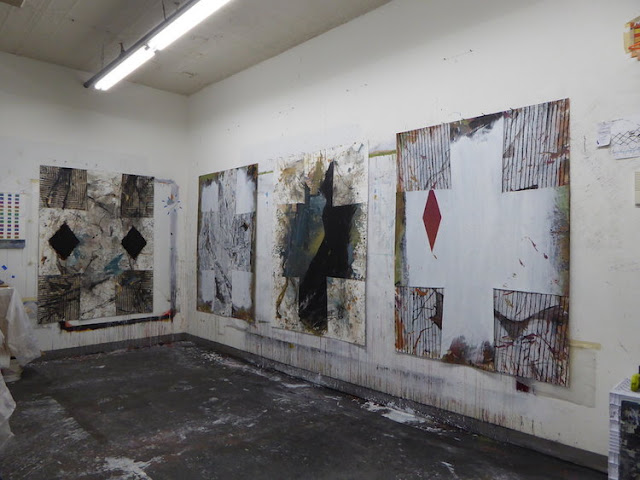April 2019 Unicorn Of The Month: Rafael Vega
 |
| Rafael has an enviable studio space in NYC and I frequently tell him so on Instagram. |
Like last months Unicorn Edra Soto, Rafael Vega is School of the Art Institute of Chicago alumni. Since Rafael is the third SAIC alumni to be featured on this blog, it may seem like I am a bit biased toward artists from my alma mater. The truth is I am, and I am ok with that!
Vega lives and works in New York and Puerto Rico. After completing his BS-Industrial Chemistry (2003) and BA-Painting (2007) at the University of Puerto Rico, he received his MFA with a major in Painting and Drawing from the School of the Art Institute of Chicago in 2012.
 |
Untitled. Acrylic, charcoal, canvas on panel. 24 x 18 in. 2018
|
 |
Untitled. Acrylic, charcoal, canvas on canvas. 64 x 48 in. 2016
|
One of the many aspects that I enjoy about this portion of the blog is learning about the influence of other artists. When I look at Rafael's work I can instantly see the influence of icons like Barnett Newman and Mark Rothko. The way that Rafael cuts and slashes the canvas and really trashes the surface, in a good way, strongly references Lucio Fontana. On this blog I try to feature artists who, like Rafael, contribute to conversation of art history, in a way that looks back and forward at the same time.
 |
Untitled. Acrylic, charcoal, canvas on canvas. 64 x 48 in. 2018
|
 |
Untitled. Acrylic, charcoal, canvas on panel. 24 x 18 in. 2018
|
Who are you? ...I always wanted to be a scientist; first a paleontologist, then an archaeologist, a nuclear physicist, astrophysicist, etc: Every option highly influenced by the Science section in the Sunday newspapers I read as a kid. But at the same time, for which I have no explanation, I also wanted to be a painter. So I went to college, completed my chemistry major and almost immediately started my fine arts education.
What's on your mind right now? Everything and huge moments of nothing. I'm easily distracted, kind of like a cat. That's why I say "everything and huge moments of nothing." Recently, I was really concerned with how to read faster, how to be more efficient when it comes to reading a book. My main problem is not just that I spend too long on one page, it's that subsequently I spend like two hours pulling, pushing, and forcing weird connections from sports to arts to science. At that point, my mind looks like a nautical chart, and I have to re-read the same page. It's not an eternal cycle, but it definitely slows things down. Every day I have to confront several unfinished books and their judgmental silence.
 |
Untitled. Acrylic, charcoal, canvas on panel. 24 x 18 in. 2018
|
 |
Untitled. Acrylic, charcoal, canvas on panel. 24 x 18 in. 2018
|
 |
| Detail |
How do you get this stuff out? Putting it out is the easy part. Putting it out in a way that makes sense to you (the artist, that first and contaminated viewer) and at the same time can fit into an external narrative, that's different, that's the balancing act.
How does it fit together? In general, I maintain tons of distance and skepticism, a kind of apprehensive state in which you are not too close or far from your ruminations. It helps build some awareness and a sense of editing, and not just editing during the making, but beforehand. What's relevant? What's just fog? Remember the nautical chart? Well, this strategy is really helpful for me. In terms of my paintings, I have a kind of fragile genealogy or lineage of shapes that, with a specific and immediate context, become forms pertinent to me: a personal mythology. Every new painting should - or at least I expect it to - question the previous one. It must force its immediate past into a state of "vibration" (try to imagine a delocalized electron), by small tweaks, never too dramatic. It must question its assumptions/urgencies/resistances/negations not for the instant gratification an answer can provide, but because that's the only way for a painting to breathe and be pertinent. A painting becomes a moving target, similar to what the theoretical biologist Stuart Kauffman calls 'an adjacent possible'.
What brought you to this point? Patience, plenty of time in the studio, and discipline. Doing, doing, doing. Lots of sketches and notes.
Can you control it? Well, there's no absolute answer for that. Where in the equation should we put training (self-taught or art school), muscle memory, taste, etc? That educated intuition seems to have a prefixed set of solutions depending on the problem, solutions that keep emerging/repeating from painting to painting. I could say ‘yes,’ if a certain impulse or urgency is added, but we can also spend an infinite amount of time identifying the burden of proof for each argument.
Have you ever destroyed one of your paintings? The kind of destruction that looks for the total oblivion of the image or picture? Nope. Honestly, I don't recall ever destroying any painting. For sure pentimento (alteration), but no destruction per se.
What's next for you, and what's next for painting? No idea.
To view more of Rafael's work, visit his Website, and his Instagram Page. He was also featured in
Vitamin P3 - New Perspectives in Painting, so be sure and get your copy.




Comments